MOIRCS grisms
Available grisms and sensitivities
MOIRCS spectroscopy mode has been operating with two low-dispersion grisms and four medium-dispersion grisms.
Two low-dispersion "zJ500" and "HK500" grisms are characterized by its wide wavelength coverage and high throughput. The zJ500 grism is optimized for the observation of 0.9-1.8 micron regions, while the HK500 grism is optimized for 1.4-2.5 microns. Their resolution is designed to roughly R~500 under 0".5 slit width. Spectral resolution is defined by the slit width: higher resolution can be achieved for narrower slit width.
We have several medium-dispersion (R ~ 2000 to 3000) grisms, most of which are made by users and kindly donated to the observatory. The users of the medium-dispersion grisms (especially for the VPH grisms below) should well understand their characteristics before applying for observation.
The "LS_J" and "LS_H" grisms are our relatively new medium-dispersion grisms for J- and H-bands. A team of scientists in Tohoku Univ, Riken, Subaru Telescope, Tokyo Univ have developed them using novel gratings provided by LightSmyth Co.. They have similar spectral resolution to the old VPH-J/H grisms, but with higher and flatter transmission curve. The dependence of the sensitivity with the slit position is minimal so should be easier to use than these old VPH grisms. Users of the grisms should visit the LightSmyth Grisms page for more.
The "VPH-Y" grism was originally the user grisms for their science. Though its peak efficiency is high, its efficiency curve is fairly peaky, with the peak wavelength changing with the position of the slit you cut. Due to these special characteristics, the use of the grism needs a deep understanding of their behavior, Please read the VPH Information Web page for more. Note that, though we still have the VPH-K grism for S24B, it will be replaced to the better performance VB_K grsim (see below).
The "VB_K" grsim is a new high performance grism for the K-band medium-dispersion spectroscopy. It was developed by a team led by Dr. Ebizuka in Riken as an application of their developed high efficiency Volume-Binary grating (Ebizuka et al. 2024, in prep.). Similar to the LS_J/H grisms, it has both wide and high transmission curve across K-band window. We thank all the efforts they paid for our community.
Estimated sensitivities listed are for a 5 sigma detection per pixel in 1 hour of on-source background-limited spectroscopy (0.5" slit is assumed). They are calculated using the measured MOIRCS efficiency which includes the efficiency of telescope and instrument optics, as well as atmosphere. The measured sky brightness between lines are used for calculation. Note that the majority of the spectra is under the OH night emission line for R500 grism, which makes the actual limiting magnitude around that wavelength regions significantly shallower (0.5 - 1 mag) than the values quoted.
| Grism Type |
Grism name |
Operating range [um](*3) |
Resolution (0.5'' slit) (*1) |
Straight-through Wavelength [um](*2) |
Dispersion [A/pixel] |
Sensitivity (Vega magnitude) [mag/arcsec2] |
|---|---|---|---|---|---|---|
| Low Dispersion |
zJ500 | 0.9-1.8 | 464 (ch1) 463 (ch2) | 1.12 | 5.65 (ch1) 5.66 (ch2) |
Y=21.8 J=21.3 |
| HK500 | 1.3-2.3(*4) | 571 (ch1) 531 (ch2) |
1.933 | 7.91 (ch1) 8.51 (ch2) |
H=21.0 K=20.0 |
|
| Medium Dispersion |
VPH-Y | 0.9 - 1.1 | 3180 | 1.017 | 0.764 | Y=20.8 |
| VPH-K(*5) | 1.8 - 2.5 | 2605 | 2.180 | 1.96 | Ks=19.3 | |
| LS_J | 1.05 - 1.4 | 3490 | 1.242 | 0.834 | J=20.4 | |
| LS_H | 1.4 - 1.9 | 3390 | 1.625 | 1.122 | H=19.9 | |
| VB_K | 1.8 - 2.5 | 2623 | 2.195 | 1.96 | Ks=19.3 |
(*1) At the straight-through wavelength. The spectral resolution changes with the wavelength proportionally. See the Figure below for the values at other wavelengths.
(*2) Straight-through wavelength is actually the function of the angle of incidence (= slit position on the detector). The measured offset for HK500 grism is about 170 A, with the shorter wavelength for the innermost slit (the shorter wavelength side) and the longest wavelength for outermost slits (longer wavelength direction).
(*3) The operating wavelength range will be limited by both use of the filter and where you put slit on a mos mask. The latter is important: if you put a slit near the edge of a detector, the spectra from the slit will be quickly dropped off from the detector edge. The actual covering wavelength range can be calculated from the straight-through wavelength, the dispersion, and the position of the slit during the mask design. The medium-dispersion grism users with MOS have to be pay enough caution on whether the features of your interest are actually on the detector with your particular mask design.
(*4) This is valid with the OC_HK order-sorting filter. When the OC1.3 order-sorting filter is used instead, the number will be 1.3 -- 2.5 um but with a significant rise of the thermal background noise.
(*5) VPH-K grisms will be decommissioned by the end of S24B, as a better performance VB_K grism is now available.
General Comments:
-
The YJHKKs imaging filters are also available for the R500 spectroscopy. They can be useful for more multiplicity. A care should be paid to the location of the second-order spectra for zJ500+Y setting (it will appear at 1450 pixel from the slit position).
-
You can take the H-band spectral data by both zJ500 and HK500 gratings. Sensitivity is 10-40% better for HK500 grism especially for red side, though the spectral resolution is a bit better for zJ500 grating.
-
We replaced the old OC_1.3 order-sorting filter to new one in October 2007, because the old filter introduced a significant second-order light longer than 2.35um. The order-sorting filter for HK500 is with thermal cut (OC_HK: 1.3--2.3um), which effectively suppress the background noise. Currently the use of OC_HK filter is the default order-sorting filter for HK500. If your science requires the data longer than 2.3um, you should use OC1_3 order-sorting filter instead.
-
We decommissioned the R1300 medium resolution grism in 2020 due to the technical issue (see the website for more detail).
-
We changed the turret position of order-sorting filters (OC_zJ and OC_HK) in July 2008. The relative sensitivity between channel 1 and 2 and flat patterns should have changed slightly from the previous layout, though they should be small.
-
The installed direction of all the VPH grisms were rotated by 180 degree in late 2015 so that the dispersion direction of them to become the same as the other grisms.
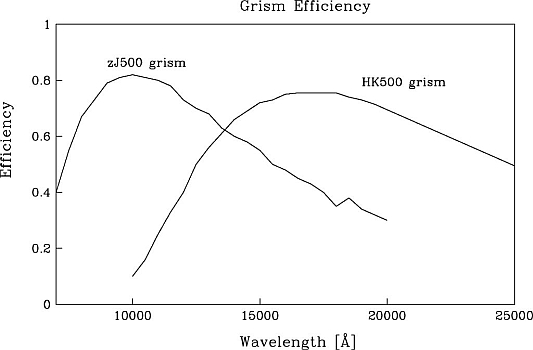
|
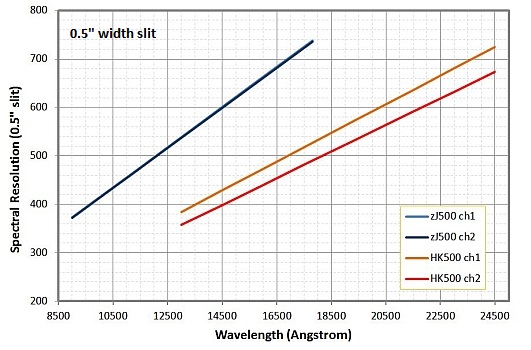
|
Figure 1:
(Left) The efficiencies of the zJ500 and HK500 gratings only (from the company datasheet: Tokoku et al. 2007 Ph.D. thesis). (Right) The spectral resolution of R500 grisms as a function of wavelength (0.5"-width slit is assumed). Note that the spectral resolution is inversely proportional with the slit width, up to 0.3".
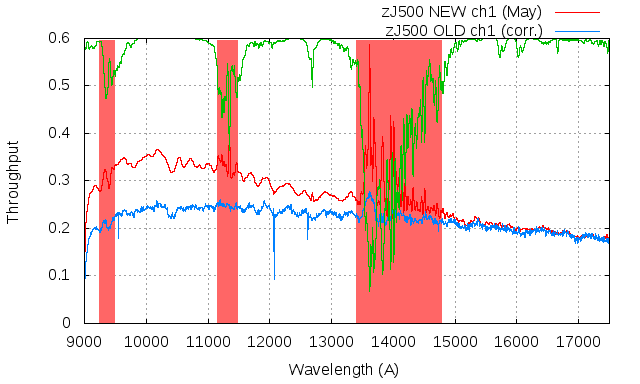 |
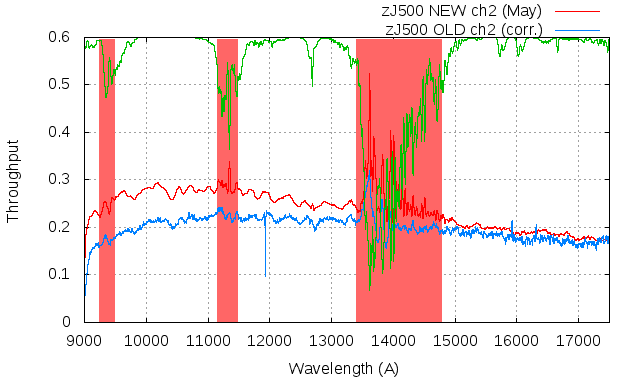 |
Figure 2(a):
Total throughput (telescope + instrument) for zJ500 grism (Left = channel 1 / Right = channel 2; red, May 2016 data). The throughput with the old Hawaii-2 detectors (before 2015, measured using the same standard star) are also shown in blue for comparison purpose. The ripple pattern in the curve is from the order-sorting filter (OC_ZJ: see the figure below). Note that the system throughput shown here includes the local variation of the detector QE, which is quite large for old detector.
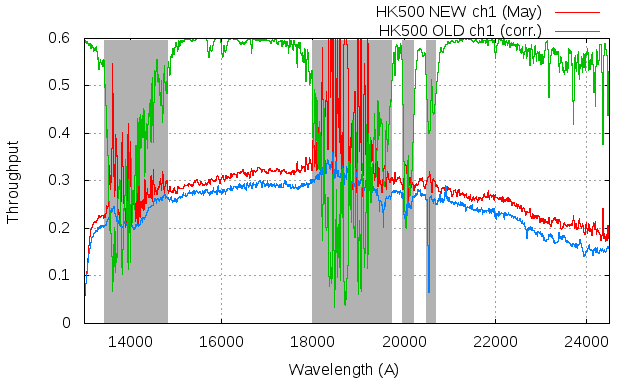 |
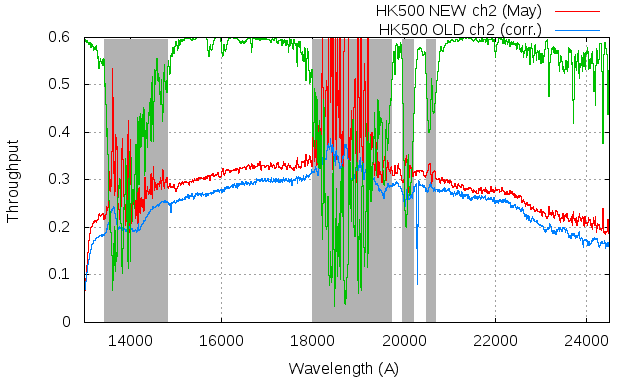 |
Figure 2(b):
The same figures as Figure 2(a), but for HK500 grism (Left = channel 1 / Right = channel 2; red, May 2016 data).
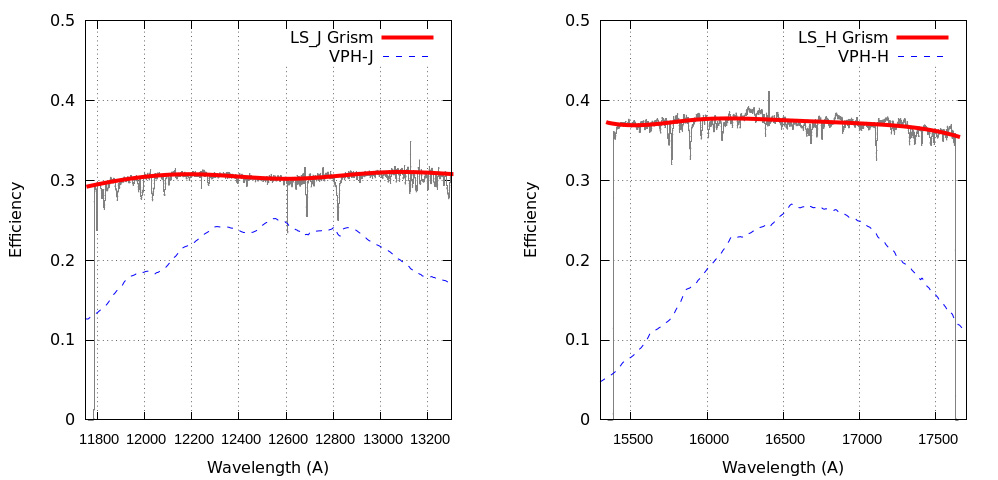 |
Figure 3:
Total throughput of the LS_J grism (Left) and LS_H (right) grism. They are measured with a slit near the center of channel 1.
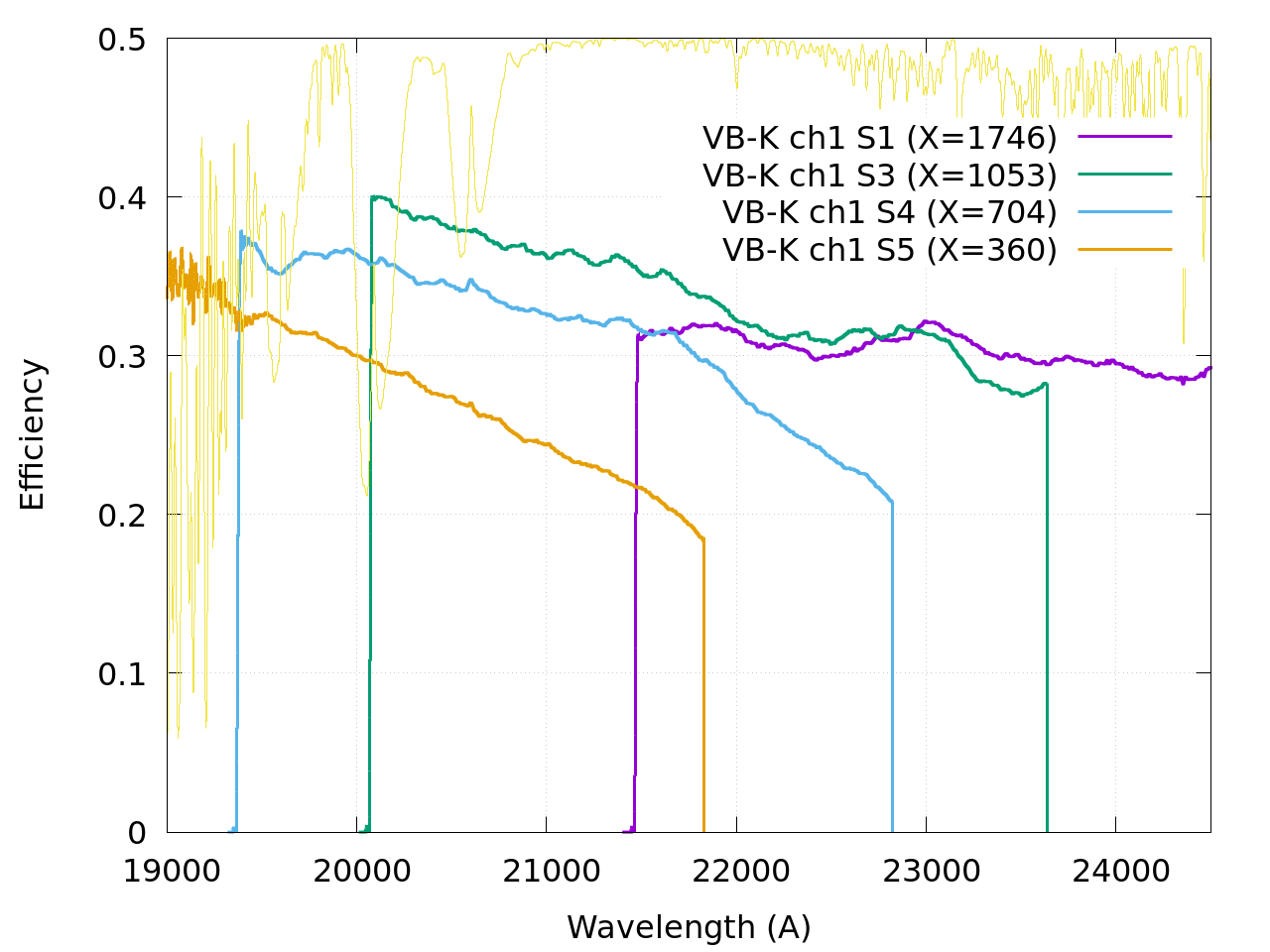 |
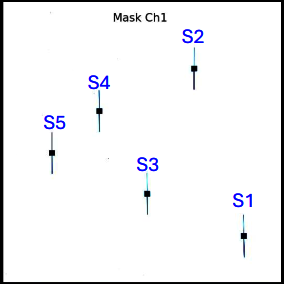 |
Figure 4:
[Left] Estimated total throughput of the VB_K grism at various slit position, along with the explanatory figure for the slit positions (in ch1 raw image). They are calculated from the dome flat data and the previously measured VPH-K grism throughput. The X coordinate shown in the figure is the slit position in raw data: larger X indicates the slit closer to the pointing center (near the mosaic boundary: see Figure 6 below). The trend is the same for ch2: namely longer wavelength range can be observed at the slits that are closer to the mosaic boundary. This figure will be updated once we get the actually measured data.
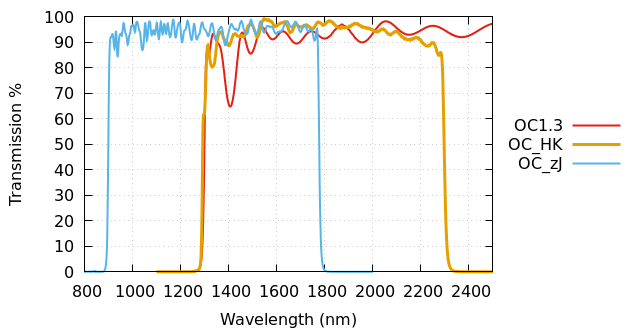 |
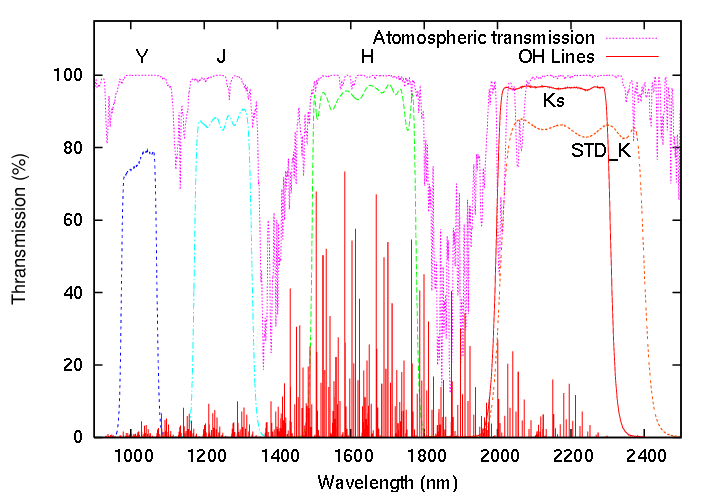 |
Figure 5:
[Left] Transmission curves for the order-sorting filters (OC_zJ for zJ500, OC_HK and OC1.3 for HK500). [Right] Those for the YJHK imaging filters. They can also be used with the grisms.
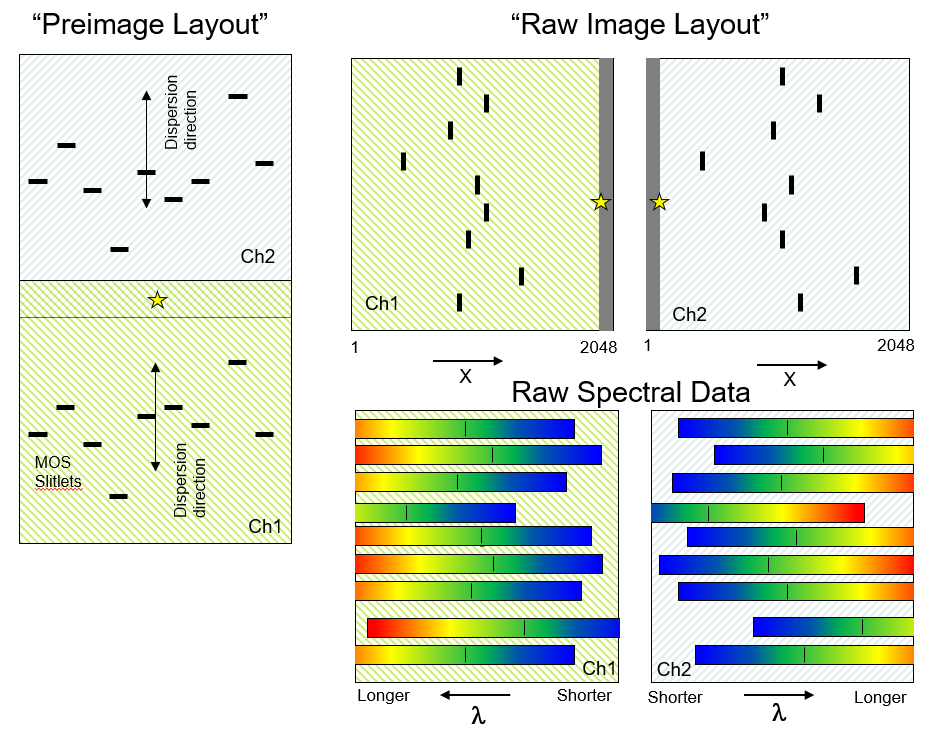 |
Figure 6:
Relation of the fits data layout between the "preimage" (used for mask design), "raw mask image", and the "spectral data". The pointing center is shown in yellow star mark. Note that the spectra is cut out by the detector edge when the spectra is too long (this is the case for medium-resolution grisms). Users should carefully design a mask to make sure that the spectral range of interest is securely on the detector.
User Grisms
Although we have been accepting the user grisms, the port for new grism is not available any more. Enough discussion with the observatory is highly recommended if you want to make the new user grisms. The detail and the basic acceptance policy can be found in the User Filter/Grism Policy page.
OLD MOIRCS Grism Page
The old MOIRCS grism website before the 2016 upgrade can be found here.
Please note that all data on these pages are subject to change as the evaluation of the performance of MOIRCS progresses.
Updated on July 25, 2024